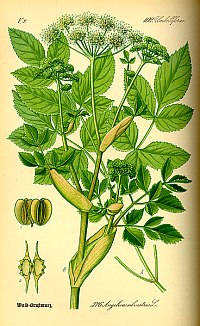Angelica History – Name Origin
(Archangelica officinalis)

Angelica was once considered one of the most powerful herbs. It was given the nickname of ‘Root of the Holy Ghost’.
Angelica is somewhat unique because it is one of the few aromatic plants that are native to the colder climates of northern Russia, Lithuania, and Norway and in even colder regions. Angelica history, according to at least one work, included its use as a life-saving food. Inhabitants of Iceland were said to have relied on Angelica when other food was unavailable.
Angelica History – Early Uses
Historically, angelica was thought to be under the protection of Michael the Archangel because it blooms on his feast day, May 8th on the old Julian Calendar. Others gave it this holy name due to its seeming ability to cure anything. For both reasons, it was considered to be a great defense against evil spirits, witches, spells and the plague.
Paracelsus (1493-1541), an alchemist and physician, who lived during the plague epidemic of 1510 in Milan, referred to Angelica as a ‘marvelous medicine’ for treating the illness. Paracelsus, born Phillip von Hohenheim, took the name Paracelsus (meaning “equal to or greater than Celsus”) in what would appear to be a claim that his expertise and knowledge exceeded that of the Roman from the 1st Century known for his tract on medicine.
Gerard, author of Herball or Historie of Plants(1597), a work that borrows its information liberally from Dr. Priest’s earlier work Pemptades (1583), claimed, “If you doe but take a piece of the roote and holde it in your mouth, or chew the same between your teeth it doth most certainly drive away the pestilentiall aire, yea although the corrupt aire have possesses the hart, yet it driveth it out again.” Pestilentiall aire? It is thought that reference relates to Angelica’s use for the relief of flatulence. But, I’ve also seen a recent reference which used ‘pestilentiall’ in reference to the air surrounding plague victims.
The history of angelica includes its use as a cure for the plague. It was used as a plague curative until the time of Charles II (Charles Stuart, 1630-1685), King of England, Scotland and Ireland.
The Danes were among the first to produce and market candied Angelica. By the early 17th Century, England was using the roots and stems to create the sweet-tasting and popular treat. It was believed that candied Angelica was a confection that was also useful for expelling wind and ‘strengthening the stomach’ and only candied Ginger enjoyed a greater popularity.
In Lapland, garlands of Angelica were given to poets in the hope that its perfume would prove inspirational. Norwegians used the roots to create bread and the French used the plant to manufacture a variety of liquors, the most well-known of which being Chartreuse.
Aromatic oil of angelica has been used to a lesser degree in perfumery.
Angelica History – Early Medicinal Uses
In researching the history of Angelica, I found that throughout history Angelica was attributed with being an effective treatment for flatulence, indigestion, chronic bronchitis, typhus, a variety of women’s reproductive health issues, and joint pain. Modern herbalism continues to use essential Angelica oil as a rub for joint pain.
Chinese Medicine
No history of angelica would be complete without mentioning the Chinese. They have been using it for over 4,000 years. However, when the term ‘Chinese Angelica’ is used, they are referring to a different plant than angelica archangelica, they are referring to Angelica Sinensis.
Additional Angelica Information.
Along with this introduction to the history of angelica, Our Herb Garden also has guides on Growing Angelica, Angelica Companion Planting and Medicinal Uses of Angelica Sinensis.